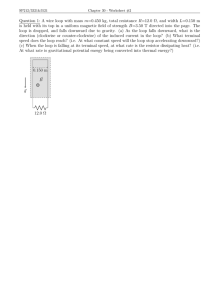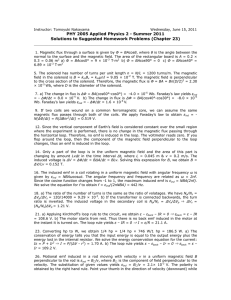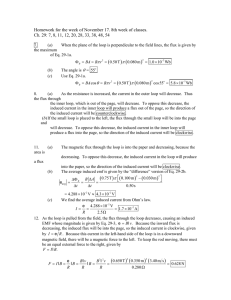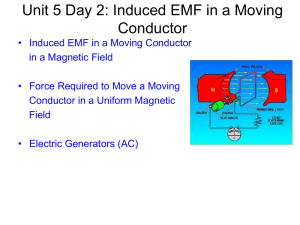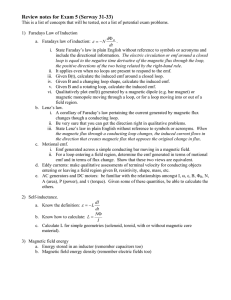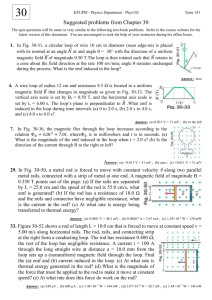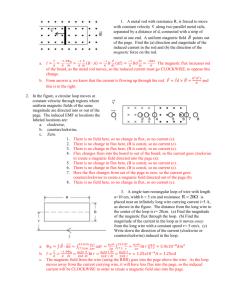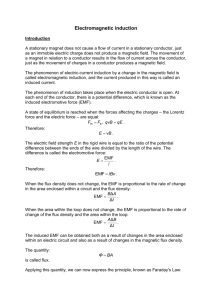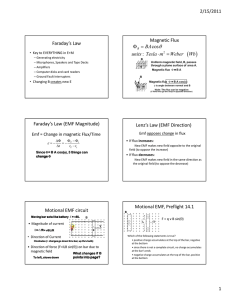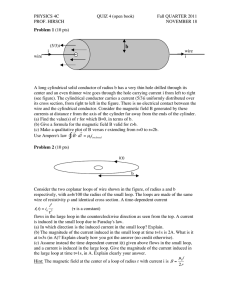Homework 7 solutions
advertisement
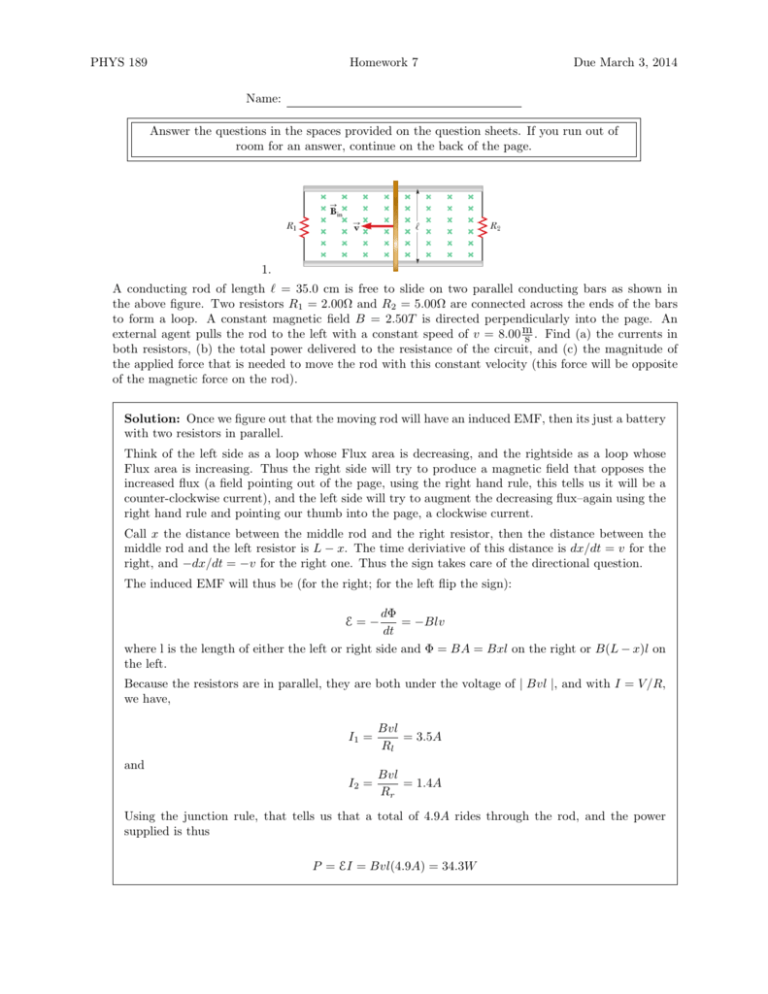
PHYS 189 Homework 7 Due March 3, 2014 Name: Answer the questions in the spaces provided on the question sheets. If you run out of room for an answer, continue on the back of the page. 1. A conducting rod of length ` = 35.0 cm is free to slide on two parallel conducting bars as shown in the above figure. Two resistors R1 = 2.00Ω and R2 = 5.00Ω are connected across the ends of the bars to form a loop. A constant magnetic field B = 2.50T is directed perpendicularly into the page. An external agent pulls the rod to the left with a constant speed of v = 8.00 m s . Find (a) the currents in both resistors, (b) the total power delivered to the resistance of the circuit, and (c) the magnitude of the applied force that is needed to move the rod with this constant velocity (this force will be opposite of the magnetic force on the rod). Solution: Once we figure out that the moving rod will have an induced EMF, then its just a battery with two resistors in parallel. Think of the left side as a loop whose Flux area is decreasing, and the rightside as a loop whose Flux area is increasing. Thus the right side will try to produce a magnetic field that opposes the increased flux (a field pointing out of the page, using the right hand rule, this tells us it will be a counter-clockwise current), and the left side will try to augment the decreasing flux–again using the right hand rule and pointing our thumb into the page, a clockwise current. Call x the distance between the middle rod and the right resistor, then the distance between the middle rod and the left resistor is L − x. The time deriviative of this distance is dx/dt = v for the right, and −dx/dt = −v for the right one. Thus the sign takes care of the directional question. The induced EMF will thus be (for the right; for the left flip the sign): dΦ = −Blv dt where l is the length of either the left or right side and Φ = BA = Bxl on the right or B(L − x)l on the left. E=− Because the resistors are in parallel, they are both under the voltage of | Bvl |, and with I = V /R, we have, I1 = Bvl = 3.5A Rl I2 = Bvl = 1.4A Rr and Using the junction rule, that tells us that a total of 4.9A rides through the rod, and the power supplied is thus P = EI = Bvl(4.9A) = 34.3W PHYS 189 Homework 7, Page 2 of 4 Due March 3, 2014 The magnitude of the force could be found by FB = ILB, or for fun, the work is W = FB ∆x and P = dW dt = Fb v, so, Fb v = 34.3W → Fb = 34.3W = 4.29N 8.00m/s PHYS 189 Homework 7, Page 3 of 4 Due March 3, 2014 2. This is a great question because now you can begin to understand the physics behind how your car’s engine provides power to the car and the battery and your phone. In a 250-turn automobile alternator, the magnetic flux in each turn is ΦB = 2.50 × 10−4 cos ωt, where ΦB is in webers (you have read the texbook, right?), ω is the angular speed of the alternator, and t is in seconds. The alternator is geared to rotate three times for each engine revolution. When the engine is running at an angular speed of 1.00 × 103 rev/min, determine (a) the induced emf in the alternator as a function of time and (b) the maximum emf in the alternator. (c) How does this compare to the voltage required by many electronic devices (say, five volts). Solution: We are told that 3fE = fA = 3 × 103 rev/min = 50 rev/s. Now we turn that into angular frequency, where one rev is 2π, then we have ωA = 100π. The induced EMF is: E=− dΦ = ωa 2.5 × 10−4 sin(ωa t) = 0.785V sin(ωa t) dt At 250 turns, this gives, E = 19.6V sin(100πt) The max of sin is 1, so the max EMF is 19.6 V. PHYS 189 Homework 7, Page 4 of 4 Due March 3, 2014 3. A square, single-turn wire loop, ` = 1.00 cm on a side is placed inside a solenoid that has a circular cross section of radius r = 3.00 cm as shown above. The solenoid is 20.0 cm long and wound with 100 turns of wire. (a) If the current in the solenoid is 3.00 A, what is the magnetic flux through the square loop? (b) If the current in the solenoid is reduced to zero in 3.00 s, what is the magnitude of the average induced emf in the square loop? Solution: Recall that the magnetic field in the interior of an ideal long solenoid is, B = µ0 nI = µ0 (N/l)I = 0.00188T for a flux of Φ = AB = (0.01m)2 (0.00188T ) = 1.88 × 10−7 T m. Now assume that the current is reduced uniformly to zero in 3 seconds, then dB/dt = ∆B/∆t = 0.00188T /3.00s = 6.28 × 10−4 T /s. E=− dB dΦ = −A = (0.01m)2 6.28 × 10−4 T /s = 6.38 × 10−8 V dt dt

